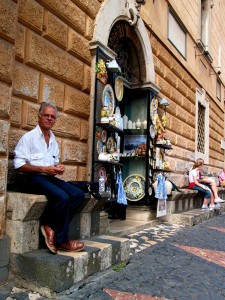Sep
08
2010
We went to Italy for almost a month. It was great. And tiring: the usual trying-to-fit-too-many-things-in kind of holiday. It’s kind of a crazy, crowded place. Even though it’s not necessarily a small country, it’s long-thinness makes it seemed crowded. The mountains running down the middle don’t exactly space things out. But, for whatever reason, I respond to so many things Italian: coffee, motorbikes, roadies decked out full regalia, driving small cars on tight little roads. A very powerful thing for me is the very sleek Italian-moderne design ethic that so often is layered over the very old, medieval foundation of so much of their country. And last, but not least, so many of the Italian towns and neighbourhoods we toured had little town squares (piazzas) in the centre of their neighbourhoods.

Cathedral square, Orvieto
I was reading La Bella Figura about how piazza’s are the centre of Italian public life and realized that there’s no where to go from our neighbourhood that’s part of my urban life. Will construction on Fraser street (at 39th or at 30th) help? Am I dreaming to think it would? And even if it’s something useful there, a cafe that people gather at, it’s going to be on a busy street. It’s not that piazza’s are always quiet, they aren’t. They can also be clogged with cars. But they’re in the *centre* of the community. Our neighbourhood quandrants that are bounded by arterials mean that the gathering places are at the edges of the neighbourhood: on the arterials. This is an inherent problem, I’d say.
The real solution would have been the corner stores which were once scattered throughout neighbourhoods like mine. If those stores still existed, they could become neighbourhood centres with the simple addition of a cafe and a table on the side walk. But there’s an inherent problem with that, too: our Vancouver neighbourhoods are nowhere near as homogeneous as they once were. While this is a huge advantage for Vancouver as a whole, it’s a problem to sustain a little business that needs support from the whole neighbourhood. The fact that those folks who don’t respond to the kind of little store/cafe I’m imagining can hop in their car and take their business somewhere else is the solution to the lack of homogeneity but the death knell for small neighbourhood stores, especially when they aren’t on the main arterial streets. Which brings us back to the problem of sitting at a sidewalk cafe table on a busy street. And, of course, the silence of my back deck is very restful and probably very good for all of us as an antidote to constant urban noise. So, you can imagine the complaining from adjacent neighbours if a little corner store put tables on the sidewalk and people sat there talking until 10pm on a summer night. This probably tends to push these activities out onto the arterial streets.
Which brings me right back to my problem of finding a way to “centre” a community with some kind of public (or semi-public) space. I just don’t know how we can do it with our current streetcar suburbs that make up almost all of Vancouver’s neighbourhoods. And if we can’t do it, it means we travel to different neighbourhoods for different needs and we become, in affect, Urban Nomads.
